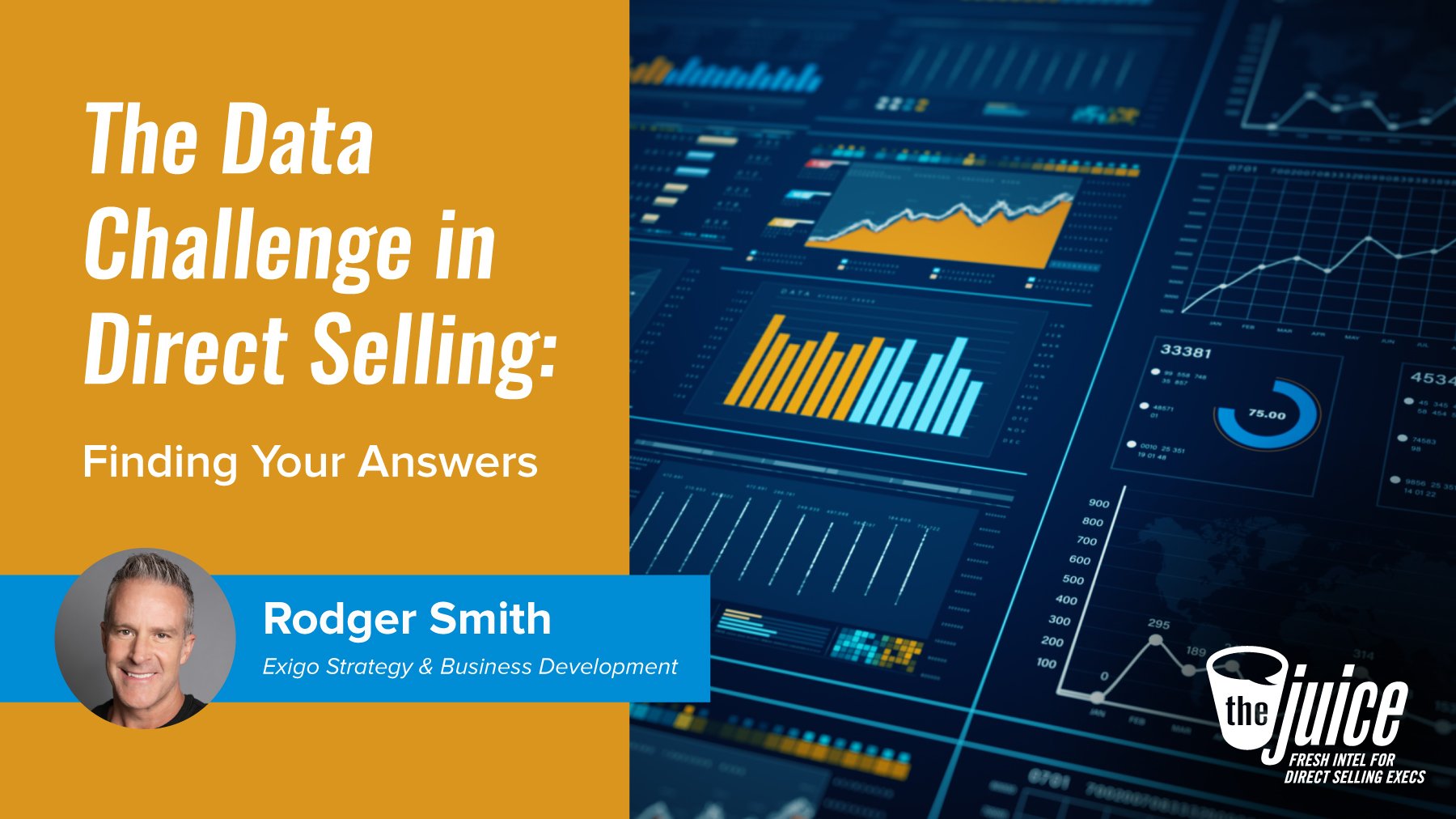The Data Challenge in Direct Selling: Finding Your Answers
The direct selling industry is known for its personal touch and community focus. It's a channel built on relationships, products and people. But even with that foundation, companies face a significant challenge: getting clear, usable answers from their business and field data.
Many companies still use old-fashioned reporting methods that make it difficult to see what is really happening in the business. This lack of visibility slows down decision-making and makes it harder to adapt to market changes. To remain competitive and grow, you need a deep understanding of your critical business information.
Because Exigo partners with so many companies, we get to see what's happening across the entire direct selling channel at a macro level.
This is a perspective that individual companies cannot get on their own. Our Exigo Insights platform gives us a front-row seat to the trends shaping the industry. In this article, I want to share some of the insights we've gained.
Key Takeaways
Many direct selling companies rely on outdated data methods, making it hard to see true business performance and trends.
Most common business intelligence (BI) tools are often expensive and complex, requiring specialized data teams to maintain.
Data visibility helps leaders and teams make faster decisions, improve processes and find new sales trends in the field and markets.
Industry averages reveal key opportunities, such as the low percentage of customers who place a second order, which can be addressed with targeted outreach.
The most useful data is built specifically for direct selling, offering instant access to key performance indicators like new enrollments, customer inactivity and autoship performance.
The Challenge of Business Visibility
Companies that lack clear data visibility often find themselves flying blind. When you can’t quickly see your key sales numbers, you can’t make informed decisions. Across the industry, for example, around 22% of customers who are allowed to create a new customer record never place an order. They become orphaned. Another significant opportunity lies in the fact that around 30% of customers that place a first order never place a second one. Getting this kind of specific, actionable data is a major hurdle for many companies.
Large business intelligence (BI) tools like Tableau or Domo can be expensive and take months to implement, and they often require data science teams to set up and manage. You need answers now, not months from now.
Without the right data, you can't see the full picture of your business. You can't understand what drives sales, customer behavior and representative actions. This lack of insight affects everyone, from executives trying to set strategy to marketing teams trying to engage customers.
Beyond the Numbers: The Importance of Industry Data
Understanding your own company’s numbers is only half the battle. Knowing how you compare to industry averages is the other half.
For instance, across the industry, autoship makes up only about 30% of sales revenue. On average, retail customers only stay on autoship for around 9.5 months, while distributors stay on for 19 months.
These benchmarks provide context for your own performance and highlight areas for improvement.
One Exigo customer, for example, has seen consistent growth for three years straight, even during times of industry volatility. This company is growing even though it has a low percentage of customers and distributors on autoships. This shows that there is no single formula for success; what matters is knowing your own numbers and being able to make decisions based on them.
The direct selling channel's repeat order rate provides a key contrast to general e-commerce. While it's a concern that 30% of customers don't place a second order, the fact that 70% do is a powerful statistic. This is significantly higher than the average repeat purchase rate for general e-commerce, which typically falls between 20% and 40%. This highlights the strength of the direct selling model and the power of personal relationships to drive repeat business.
Recent industry data shows the market can be volatile. As referenced by Stuart Johnson’s article, a Direct Selling News survey of 100 of the largest direct selling companies in North America found that in the first half of 2025, the following occurred:
50% of companies saw revenue growth of at least 2% year-over-year.
12.5% of companies were flat (±2%).
37.5% saw revenue declines of 2% or more.
This data shows a shift from the high volatility of 2024 to a more steady, flat trend in 2025. This kind of information is critical for setting realistic goals and expectations.
Geographic Trends and Opportunity
Using a business intelligence platform to track regional sales gives you a clear picture of where your sales are coming from and where you should focus your efforts. Here is what Exigo's platform data revealed about global sales over the last 12 months:
The Americas are a dominant market. The region (North, Central and South America) comprised 78% of the total global revenue that flowed through the platform. This shows the Americas remain a powerhouse for the channel.
Asia shows a solid presence. Asia made up 11% of the total, with Japan, Hong Kong, China and Taiwan leading the charge. These markets demonstrate the global reach of the industry.
Europe and Africa show potential. Europe came in at 7% (led by Spain, Germany, and France), and Africa represented 3% (with a strong lead from Nigeria). These are growing markets worth a closer look for targeted strategies.
Getting Actionable Data at Your Fingertips
Having the right data means going beyond simple spreadsheets. You need a way to see key performance indicators (KPIs) like new enrollments, customer inactivity and autoship performance with a few clicks. The goal is to make faster, more informed decisions.
Your data is a powerful asset, but it’s only useful if you know how to turn it into action.
Here are some ways to leverage the kind of data visibility your company needs for growth:
Find and engage orphaned customers. Around 22% of new customer records across the industry never place an order. This is a large, untouched group. You can use your data to find these customers and launch a specific campaign to give them a reason to make that first purchase. But you should also look at your user experience. Consider letting customers place an order without first creating an account.
Encourage the second order. Roughly 30% of customers who place a first order never place a second one. You can use this data to identify this group and create an outreach campaign. Offer a targeted discount or a personalized message that encourages them to come back and make another purchase.
Improve autoship retention. The industry averages for autoship retention are low, but your own data can show you why customers are canceling. Use it to find patterns—for example, which products or which teams have the lowest retention. Then, build a plan to address those specific issues.
Go beyond the industry average. Recent survey data shows the market is mixed, with some companies growing and others declining. Instead of just chasing industry averages, use your unique company data to find what works for you. One Exigo customer with consistent growth has a low percentage of autoships and pays less in commissions than the industry average. This shows that your path to success is your own, and your data can guide you to it.
Empower regional leaders. Use data to compare how specific regions or markets are performing. You can see how a specific rank's sales are doing in different areas. This allows you to tailor support, training, and incentives to the needs of each market.
Prepare for the future of business. Having all your data in one cohesive system is not just about better reporting today. It’s also about preparing your company to leverage artificial intelligence (AI) and other future technologies, which rely on a single, clean data source to provide meaningful insights and automation.
A Better Approach to Data Visibility
The goal of technology should always be to support your main focus: your products and your people. When data tools are too complicated or expensive, they become a distraction.
Exigo helps companies run their business with confidence, know their business deeply and grow their teams and markets quickly. A proven platform streamlines operations, helps the field and boosts sales.
Exigo Insights provides over 120 BI reports and dashboards built specifically for direct selling and MLM companies.
Industry experts built it to be a strong base for any direct selling company, meaning you get access to data and metrics made for direct selling, something no other provider can offer. You can start using it in days, at a lower cost and without needing a dedicated BI team. The platform empowers companies and representatives to become more results-focused.
Conclusion
In today’s direct selling landscape, relying on outdated reporting methods is a serious disadvantage. The ability to see your data clearly, quickly, and in the context of industry benchmarks is no longer a luxury; it's a necessity. It’s what separates companies that are growing from those that are standing still. By finding a way to get actionable, industry-specific data at your fingertips, you can better understand your business, improve your processes, and empower your teams to focus on what truly drives results.







